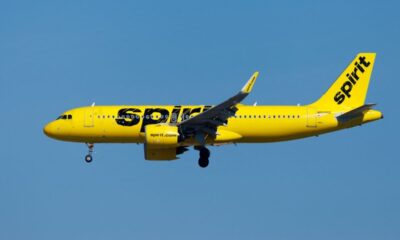World
Boeing’s Aircraft Production: Assessing Numbers and Challenges

Boeing, one of the world’s leading commercial aircraft manufacturers alongside Airbus, is navigating a complex landscape of production and delivery challenges. In 2024, Boeing delivered only 348 commercial aircraft, marking a significant decline from pre-pandemic figures and representing its lowest total since early 2020. This downturn highlights the ongoing impact of regulatory scrutiny, supply chain disruptions, and quality control issues that have characterized the aerospace industry in recent years.
Understanding Boeing’s output requires clarity on the distinction between production and deliveries. Production refers to the number of aircraft built within a specific timeframe, while deliveries are the aircraft that are fully completed, tested, and handed over to customers. Typically, delivery figures serve as the performance benchmark since they directly correlate with revenue. However, Boeing’s production ability has often surpassed its deliveries, particularly in recent years when inventory has built up due to certification delays and logistical bottlenecks.
Production Versus Delivery: A Key Distinction
The divergence between production and delivery numbers has become pronounced at Boeing. A significant portion of its inventory consists of aircraft awaiting certification and customer acceptance. This includes hundreds of Boeing 737 MAX jets, which were produced during the global grounding period. As Boeing works to reduce this backlog, it faces the challenge of aligning production rates with supplier capabilities and regulatory approvals.
In 2024, the company experienced a series of internal and external challenges that contributed to the reduced delivery count. Following heightened quality inspections, Boeing enhanced its protocols across production lines, adding complexity and time to the manufacturing process. Labor disruptions and shortages of critical components, such as engines, further exacerbated the situation. Boeing’s leadership has acknowledged that while factory throughput is improving, the pace of certified deliveries remains cautious and measured.
Looking Ahead: Forecasts for 2025
Boeing’s outlook for 2025 appears more optimistic, with projections suggesting potential deliveries of between 580 and 600 commercial jets. This anticipated recovery represents approximately 70% growth compared to 2024, indicating a gradual return to pre-crisis production rhythms. Central to this recovery is the 737 MAX line, which remains a core component of Boeing’s commercial offerings. The company has stabilized its production rate of the 737 MAX at 38 aircraft per month, with plans to increase this to 42 aircraft per month following regulatory approval.
Additionally, the production of the Boeing 787 Dreamliner is expected to ramp up, driven by renewed international demand. By diversifying its production portfolio, Boeing aims to maintain steady output without overextending its facilities.
Despite these positive forecasts, Boeing’s ability to reach its targets hinges on clearing its existing inventory of aircraft. Many of the anticipated deliveries will include previously completed jets that are now ready for customer handover. This intricate balancing act between production and backlog reduction will be crucial for the company’s recovery trajectory.
Boeing faces several constraints that could impact its growth. Regulatory oversight has increased significantly since the 737 MAX incidents, resulting in tighter scrutiny of Boeing’s quality systems and production rates. Certification delays, particularly for the 737 MAX 7 and MAX 10 variants, limit Boeing’s output capabilities, as these aircraft are essential to meeting specific airline demands.
Supply chain fragility remains another critical issue. Manufacturers of engines and electronic components are still grappling with disruptions stemming from the pandemic. A single shortage can halt production, emphasizing the importance of stable supply chains for Boeing’s future operations.
Reflecting on Boeing’s historical performance, the company delivered a record 806 aircraft in 2018. Since then, production has faced significant hurdles, including the grounding of the 737 MAX and the global impact of COVID-19. Today, Boeing’s monthly delivery rate hovers between 40 and 60 jets, a stark contrast to the 70-80 per month rates achieved during peak years.
As Boeing navigates these challenges, it aims to build a sustainable production foundation rather than simply replicating its historical records. Continuous improvement in output and delivery performance is essential for Boeing to regain its status as a leader in the aerospace sector.
Looking ahead, Boeing’s growth path is contingent upon various factors, including regulatory confidence, supplier performance, workforce stability, and airline demand. If conditions remain favorable and disruptions are minimized, analysts predict Boeing could achieve annual production levels of 600 to 700 aircraft by 2026 or 2027. However, risks remain significant, including potential quality incidents, part shortages, and fluctuations in global demand.
Boeing’s production rate will serve as a barometer for its recovery from the challenges of the past decade. The company’s capacity to increase output while ensuring safety and quality will play a pivotal role in determining its future standing in the competitive aviation market.
-

 Science1 week ago
Science1 week agoResearchers Challenge 200-Year-Old Physics Principle with Atomic Engines
-

 Politics1 week ago
Politics1 week agoNHP Foundation Secures Land for 158 Affordable Apartments in Denver
-

 Health1 week ago
Health1 week agoNeuroscientist Advocates for Flag Football Until Age 14
-

 Lifestyle1 week ago
Lifestyle1 week agoLongtime Friends Face Heartbreak After Loss and Isolation
-

 Health1 week ago
Health1 week agoFDA Launches Fast-Track Review for Nine Innovative Therapies
-

 Business1 week ago
Business1 week agoMaine Housing Inventory Surges to Post-Pandemic High
-

 Top Stories1 week ago
Top Stories1 week agoUnforgettable Moments: The Best Victoria’s Secret Performances
-

 Politics1 week ago
Politics1 week agoIsraeli Air Strikes in Lebanon Kill One, Wound Seven Amid Tensions
-

 World1 week ago
World1 week agoTroops to Enjoy Buffalo Chicken, Thai Curry in 2026 MREs
-

 World1 week ago
World1 week agoGlobal Military Spending: Air Forces Ranked by Budget and Capability
-

 Politics1 week ago
Politics1 week agoMassachusetts Lawmakers Resist Audit After Voter Mandate
-

 Business1 week ago
Business1 week agoSpirit Airlines Cuts Workforce with Furloughs for 365 Pilots









